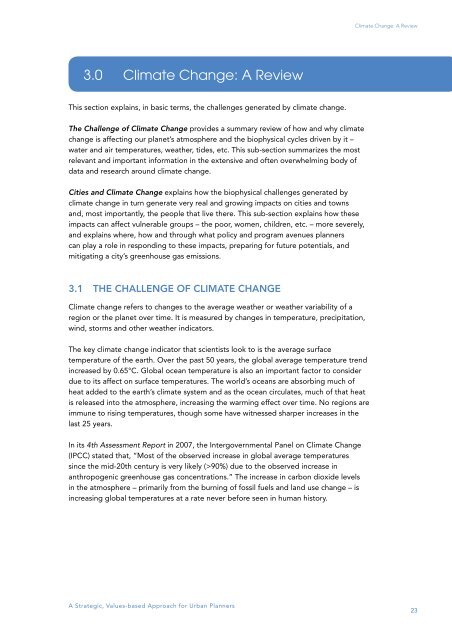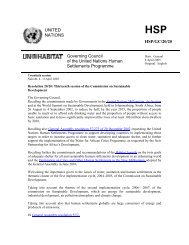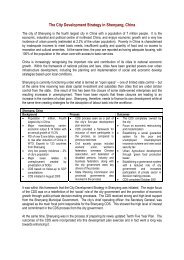Planning for Climate Change - UN-Habitat
Planning for Climate Change - UN-Habitat
Planning for Climate Change - UN-Habitat
Create successful ePaper yourself
Turn your PDF publications into a flip-book with our unique Google optimized e-Paper software.
<strong>Climate</strong> <strong>Change</strong>: A Review<br />
3.0 <strong>Climate</strong> <strong>Change</strong>: A Review<br />
This section explains, in basic terms, the challenges generated by climate change.<br />
The Challenge of <strong>Climate</strong> <strong>Change</strong> provides a summary review of how and why climate<br />
change is affecting our planet’s atmosphere and the biophysical cycles driven by it –<br />
water and air temperatures, weather, tides, etc. This sub-section summarizes the most<br />
relevant and important in<strong>for</strong>mation in the extensive and often overwhelming body of<br />
data and research around climate change.<br />
Cities and <strong>Climate</strong> <strong>Change</strong> explains how the biophysical challenges generated by<br />
climate change in turn generate very real and growing impacts on cities and towns<br />
and, most importantly, the people that live there. This sub-section explains how these<br />
impacts can affect vulnerable groups – the poor, women, children, etc. – more severely,<br />
and explains where, how and through what policy and program avenues planners<br />
can play a role in responding to these impacts, preparing <strong>for</strong> future potentials, and<br />
mitigating a city’s greenhouse gas emissions.<br />
3.1 THE CHALLENGE OF CLIMATE CHANGE<br />
<strong>Climate</strong> change refers to changes to the average weather or weather variability of a<br />
region or the planet over time. It is measured by changes in temperature, precipitation,<br />
wind, storms and other weather indicators.<br />
The key climate change indicator that scientists look to is the average surface<br />
temperature of the earth. Over the past 50 years, the global average temperature trend<br />
increased by 0.65°C. Global ocean temperature is also an important factor to consider<br />
due to its affect on surface temperatures. The world’s oceans are absorbing much of<br />
heat added to the earth’s climate system and as the ocean circulates, much of that heat<br />
is released into the atmosphere, increasing the warming effect over time. No regions are<br />
immune to rising temperatures, though some have witnessed sharper increases in the<br />
last 25 years.<br />
In its 4th Assessment Report in 2007, the Intergovernmental Panel on <strong>Climate</strong> <strong>Change</strong><br />
(IPCC) stated that, “Most of the observed increase in global average temperatures<br />
since the mid-20th century is very likely (>90%) due to the observed increase in<br />
anthropogenic greenhouse gas concentrations.” The increase in carbon dioxide levels<br />
in the atmosphere – primarily from the burning of fossil fuels and land use change – is<br />
increasing global temperatures at a rate never be<strong>for</strong>e seen in human history.<br />
A Strategic, Values-based Approach <strong>for</strong> Urban Planners<br />
23

















